How to Albatross Start Flying Again in the Ocean
How Do They Practice It? The Magnificent Wandering Albatrosses
Author: Norm Budnitz
Consider the Wandering Boundness.
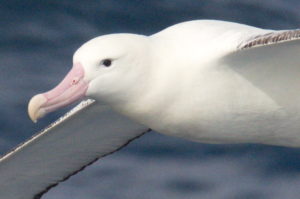 Wandering Albatross
Wandering Albatross
- Wingspan: upward to eleven feet 6 inches (My 'wingspan,' fingertip to fingertip, is 5 anxiety six inches.)
- Weight: upwards to 28 pounds (Think nearly a large Thanksgiving turkey.)
- Lifespan: maybe up to threescore years
- Travel: up to 75,000 miles per yr (circumnavigating the Antarctic ocean 3 times)
I have watched Wandering Albatrosses follow a ship I was on for hours without ever beating their wings. They simply fly in wide arcs, swooping downwind toward the h2o, then communicable the updrafts off the waves and gliding upward (chosen dynamic soaring). They tin lock their wings in this gliding posture, and then they don't have to spend energy holding their wings out. (Try belongings your artillery out for only ten minutes!) In moderate to heavy winds, albatrosses tin practise this for hours at a time with negligible energy costs. If in that location is no wind, however, they become becalmed. Hauling all that weight around becomes very expensive. But Wandering Albatrosses live in a windy function of the earth, the southern oceans, so this is rarely a trouble for them.
Wandering Albatrosses do have to land on the h2o to feed. They spot food from the air—squid, fish, crustaceans and even dead whales and seals floating at or near the surface. They rarely swoop into the water, simply rather settle onto the surface and pluck up their prey. To get off the water, they turn into the air current, flap their wings a couple of times, and get dorsum into gliding fashion.
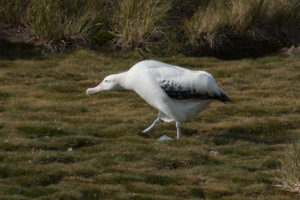 Wandering Albatross on country
Wandering Albatross on country
Albatrosses only come to country to brood on various islands in the southern oceans. As graceful as they are in the air, they are equally every bit ungraceful on terra firma. Equally they come in, they put down their landing gear (legs and feet) and try not to tumble over equally they hit the earth. It helps that they typically nest in grassy areas, and then they don't get hurt if they do tumble. And those grassy areas are well-nigh cliffs, and then that to get airborne, they merely walk to the cliff's edge and 'leap' off.
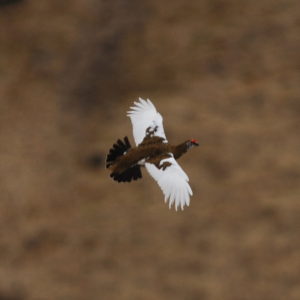 Stone Ptarmigan, loftier wing-loading
Stone Ptarmigan, loftier wing-loading
How do they do it? What are the adaptations they have gained through evolution that make it possible for them to live this amazing life in the air? First, consider the concept of fly-loading. Wing-loading is the relationship between trunk weight and wing surface expanse. The lift a bird tin can generate is directly related to the surface expanse of its wings—the more surface, the more lift. Heavy birds need to generate lots of lift in order to wing. Birds with loftier wing-loading, think chickens and turkeys (or the Rock Ptarmigan pictured hither), tend to be very heavy and have short, chubby wings. If you take ever been startled by a Wild Turkey exploding out of the trees in front of you every bit you walk quietly along a forest path, you know what it's like for a bird to have high wing-loading. Turkeys outburst into the air making a huge noise, flapping their wings very rapidly, but they don't (tin can't) wing very far. That kind of flying is expensive, and their fly muscles become tired chop-chop. Turkeys rarely wing except when they are in escape manner.
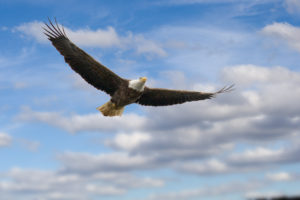 Bald Eagle, loftier aspect ratio – photo by Pecker Majoros
Bald Eagle, loftier aspect ratio – photo by Pecker Majoros
On the other mitt, a Bald Eagle, though a robust bird to be sure, has very broad, wide wings. All that fly area can generate lots of lift. Thus, eagles have relatively low wing-loading, that ratio of trunk weight to wing area, and tin generate lots of lift whether flapping or soaring.
The 2d concept to consider is aspect ratio, the human relationship between wing length versus wing width. A wing with high aspect ratio is long and narrow. Low aspect ratio wings are about every bit long every bit they are broad. An reward of long, narrow wings with loftier aspect ratio is that they take a lot of wing area for lift, simply they do non generate much turbulence every bit they movement through the air. Turbulence is a soaring bird'due south worst enemy, because it decreases lift and increases elevate. Thus, birds with high aspect ratio wings tin can soar for prolonged periods of fourth dimension and still maintain their maneuverability—i.eastward., plow on a dime. Turkeys and ptarmigans, with low aspect ratio wings, create lots of turbulence, creating all that fly flapping noise, and basically just fly fast and straight to escape from a possible predator.
Where practice our albatrosses fit into this scheme of things? They are quite heavy-bodied birds, so they take high wing-loading. But they too have high aspect ratio wings, in the farthermost. This makes up for the high fly-loading, then they can soar for hours and nevertheless be maneuverable when they need to exist.
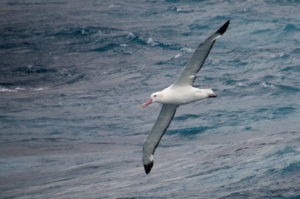 Wandering Albatross, high wing-loading and very high aspect ratio
Wandering Albatross, high wing-loading and very high aspect ratio
It is hard for humans to envision the weeks, months, even years that Wandering Albatrosses spend at sea. Only recollect of it from the albatross'due south point of view: What are those foreign creatures who spend all their time stuck fast to the land? Occasionally they go up in one of those metal fixed-wing monsters with high wing-loading. Information technology must exist rather difficult to find a squid from one of those things, let alone drop downwardly and pluck information technology from the water's surface for a tasty meal.
I bet the albatrosses adopt beingness albatrosses. Even if it means they take to drink seawater when they are thirsty. Merely that's another story.
Some of the information in this article was plucked from these sources:
Dereck Onley and Paul Scofield, Albatrosses, Petrels, and Shearwaters of the World.
David Allen Sibley, The Sibley Guide to Bird Life & Beliefs.
Wikipedia commodity on Wandering Albatross.
Photographs by Norm Budnitz except the Bald Eagle past Bill Majoros.
« Back to All PressSource: https://www.newhopeaudubon.org/blog/magnificent-wandering-albatrosses/
0 Response to "How to Albatross Start Flying Again in the Ocean"
Post a Comment